Tuo on hyvä pointti. Taitaa nousta 27 000:sta 115 000:en, ainakin suunnitelmien mukaisesti.
Eivät siis säilöneet edes kivääreitä 90-luvulla pahan päivän varalle? On ollut uskoa tulevaisuuteen.
Vanhoja valmistettiin wiki mukaan 200 000kpl.
Follow along with the video below to see how to install our site as a web app on your home screen.
Note: This feature may not be available in some browsers.
Tuo on hyvä pointti. Taitaa nousta 27 000:sta 115 000:en, ainakin suunnitelmien mukaisesti.
Taisivat aseista Latvian ja Liettuan näillä aseilla 90-luvun loppupuolella siis AK4:lla.Eivät siis säilöneet edes kivääreitä 90-luvulla pahan päivän varalle? On ollut uskoa tulevaisuuteen.
Vanhoja valmistettiin wiki mukaan 200 000kpl.

 corporalfrisk.com
corporalfrisk.com
This was also supported by a brief report by Twitter username @VerkanUnderline of the Swedish Air Force who shot the weapon at a recent TTS (‘SRA but in Swedish’) meet. He noted that the weapon is very forgiving and the aimpoint stays the same regardless of support and shooting stance, and that while the recoil unsurprisingly is rather fierce compared to a medium-length DI-gun, the speed of the impulse means that with practice it is possible to regain the target “rather quickly”. The ambidextrous control also garnered praise, and in general he was very happy with it.
In short, regardless of what the Army settles for, Hemvärnet will focus on 5.56 NATO, and there are a number of reasons for this.
---
The cost might only be approximately 1 SEK (~90 cents) more for a 7.62 NATO round as Peru explained, but giving just three mags of thirty rounds to all 26,000 soldiers will already cost you well over two million Euros more with 7.62 NATO compared to 5.56 NATO – and then we get back to the fact that the rounds are heavier and the magazines longer.
It doesn’t stop there. Such seemingly simple things as how many firing units you can fit in a given exercise area simultaneously also comes into play. When looking at the larger area needed by a unit shooting 7.62 mm compared to one equipped with 5.56 NATO, this directly translates into how efficient the parent unit can be with the precious training time allocated to it, a rather unsexy question but one that have consequences in the real world where budgets and training days are limited.

Taitaa ainut järkevä suomesta saatava olla ak 2.0 osat ja tarvikkeet ak alustasta riippumatta. normi ak sukuisiin takatähtäimen tilalle tuleva pp jalka olisi myös vaihtoehto. pelkkään kiskolliseen kanteen en paljon luottaisi osumapisteen säilymisen kannalta.Ehkä hieman oftopic mutta miettinyt tässä että jos lkp tulisi niin millä konstilla saisi jakoaseeseen punapistetähtäimen picatinnyllä kiinni? AK mallin aseisiin on tarjolla monenlaista ratkaisua mutta passaako näistä mikään palikka perus RK62:een (oletan että siinä vaiheessa mitkään koneistushommat ei onnistu) Käykö mikään ak:n laatikonkansi rk62:n? Tai etutukki/kaasuputken suoja? Toki jakoase saattaisi olla myös ddr ak tai kiinan ak, näihin varmaan löytyisi sopivia osia picatinny kiskolla?
Tuon ak 2.0:n laatikon sivuun tulevan kiskon kiinnityspulttien reikien poraamiseen on myynnissä joku sapluuna. Eli jos ostaa ak 2.0 sivukiilan pultteineen, porausadapterin ja sivujalan sekä ottaa mukaan akkuporan poran terän ja kiintoavaimet, niin pystyy teltassa (tai Kymijoen itäpuolella katetussa maakuopassa askartelemaan punapisteelle picatinnykiskon RK62 ja RK95 rynkkyihin. Eikä piä unohtaa ottaa sitä punapistettä ja sen paristoja mukaan.Taitaa ainut järkevä suomesta saatava olla ak 2.0 osat ja tarvikkeet ak alustasta riippumatta. normi ak sukuisiin takatähtäimen tilalle tuleva pp jalka olisi myös vaihtoehto. pelkkään kiskolliseen kanteen en paljon luottaisi osumapisteen säilymisen kannalta.
Ei ainakaan ilman sovituspalikoita, koska RK 95:n etutukki on pidempi kuin 62:n. Sinänsä nuo päätykappaleet ovat kai samoissa mitoissa, eli pitäisi jollain kiinnityskierteisin menevällä palikalla saada etuhelat siirretyksi edemmäs (ja hankkia 95-malliset, koska 62:n etusiderengas kiertyy suoraan).Mahtaiskohan tuollainen M92/RK95 etutukki sopia 62:een?
Ehkä hieman oftopic mutta miettinyt tässä että jos lkp tulisi niin millä konstilla saisi jakoaseeseen punapistetähtäimen picatinnyllä kiinni? AK mallin aseisiin on tarjolla monenlaista ratkaisua mutta passaako näistä mikään palikka perus RK62:een (oletan että siinä vaiheessa mitkään koneistushommat ei onnistu) Käykö mikään ak:n laatikonkansi rk62:n? Tai etutukki/kaasuputken suoja? Toki jakoase saattaisi olla myös ddr ak tai kiinan ak, näihin varmaan löytyisi sopivia osia picatinny kiskolla?
Tuon ak 2.0:n laatikon sivuun tulevan kiskon kiinnityspulttien reikien poraamiseen on myynnissä joku sapluuna. Eli jos ostaa ak 2.0 sivukiilan pultteineen, porausadapterin ja sivujalan sekä ottaa mukaan akkuporan poran terän ja kiintoavaimet, niin pystyy teltassa (tai Kymijoen itäpuolella katetussa maakuopassa askartelemaan punapisteelle picatinnykiskon RK62 ja RK95 rynkkyihin. Eikä piä unohtaa ottaa sitä punapistettä ja sen paristoja mukaan.
Minä teetin nuo reiät asesepällä, eli en ostanut itselle adapteria. Hintaa tuolle ak 2.0 varautumiselle tulee adapterin kanssa ehkä joku 300€ ja siihen ei vielä sisälly punapistehtäintä. Eli joku 700€ kaiken kaikkiaan jos akkupora on jo.
Norincoon ja Ak47:aan saa etukahvan tilalle vaihdettua picatinnykiskollisen kahvan ilman koneistuksia jollain kuusiokoloavaimella. On minulla sellainenkin, mutta en nyt äkkiä muista miten se vaikuttaa kaasumännän suojaputken irrottamiseen. Rautatähtäimiä pystyy käyttämään tuon kiskokädensijan kanssa, mutta jos asentaa punapisteen, niin silloin ei voi enää rautoja käyttää. Ellei asenna korkeata jalustaa, jonka läpi voi tähdätä avoilla, mutta sitte pitää jo kohta olla pikasäädettävä poskipakkakin (kuten mulla). Noita kiskollisia etukahvoja tais saada ihan hyviä alle satkulla.
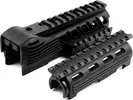
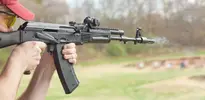
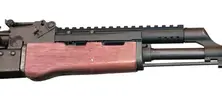
Taitaa ainut järkevä suomesta saatava olla ak 2.0 osat ja tarvikkeet ak alustasta riippumatta. normi ak sukuisiin takatähtäimen tilalle tuleva pp jalka olisi myös vaihtoehto. pelkkään kiskolliseen kanteen en paljon luottaisi osumapisteen säilymisen kannalta.
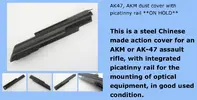
 ). Muistaakseni se oli DDR:ssä tehty ja eroaa yllä olevasta täyspitkällä optiikan kiinnitysuralla. Tekstistä poiketen Picatinnyä se ei ole nähnytkään. Onko kenelläkään tietoa minkälaista optiikkaa siinä oli tarkoitus silloin käyttää? Nämä olivat itse asiassa ainoat kuvat mitä netistä löysin.
). Muistaakseni se oli DDR:ssä tehty ja eroaa yllä olevasta täyspitkällä optiikan kiinnitysuralla. Tekstistä poiketen Picatinnyä se ei ole nähnytkään. Onko kenelläkään tietoa minkälaista optiikkaa siinä oli tarkoitus silloin käyttää? Nämä olivat itse asiassa ainoat kuvat mitä netistä löysin.Katso liite: 117525
Ostin neljännesvuosisata sitten edesmenneeltä Lähdeniemeltä Norincooni tuollaisen laatikonkannen, jota en koskaan sitten käyttänytkään. Löytyy toki yhä ”pientä ja tarpeellista” -laatikostani (jos joku tarvitsee). Muistaakseni se oli DDR:ssä tehty ja eroaa yllä olevasta täyspitkällä optiikan kiinnitysuralla. Tekstistä poiketen Picatinnyä se ei ole nähnytkään. Onko kenelläkään tietoa minkälaista optiikkaa siinä oli tarkoitus silloin käyttää? Nämä olivat itse asiassa ainoat kuvat mitä netistä löysin.
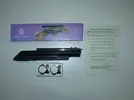
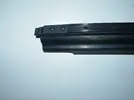
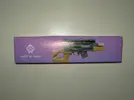
 trueaim.fi
trueaim.fi
Hyvin sen siihen saisi, koneiston tapit samoissa kohdissa kuin AKssa, niin samalla sabluunalla vaan. Laatikossa sen verran materiaalivahvuuttakin, että saisi reiät kierteytettyä, joten ei tulisi laatikon sisäpuolelle mitään ulokkeita jotka ottaisi tappien pidätinlevyyn, jne mitä siellä nyt on potentiaalisesti tiellä. Voi vetää niiteilläkin (kuten AKssa), mutta sitten pitänee viilata sitä pidätinlevyä parista kohdasta myös.Miten se venäläismallinen sivukiila kävisi kotimaiseen kivääriin, aakoovehkeiin ei liene ongelmaa. Elikkä haittaisiko sisäkaluja, kiinnihän nyt saa jos ruuveja on
Sitten vaan sodan varalta ostelemaan sivukiiloja ja jalkoja taskun pohjalle ja käypänen punapiste tai jokin linssivärkkiHyvin sen siihen saisi, koneiston tapit samoissa kohdissa kuin AKssa, niin samalla sabluunalla vaan. Laatikossa sen verran materiaalivahvuuttakin, että saisi reiät kierteytettyä, joten ei tulisi laatikon sisäpuolelle mitään ulokkeita jotka ottaisi tappien pidätinlevyyn, jne mitä siellä nyt on potentiaalisesti tiellä. Voi vetää niiteilläkin (kuten AKssa), mutta sitten pitänee viilata sitä pidätinlevyä parista kohdasta myös.
Eiköhän näitä alkaisi löytyä vähän joka toiselta tvälläriltä hyllystä valmiina melko pian tappelun alettua. Niitähän voi ottaa vaikka niistä kentältä löytyneistä AK-74stä talteen.Sitten vaan sodan varalta ostelemaan sivukiiloja ja jalkoja taskun pohjalle ja käypänen punapiste tai jokin linssivärkki
onko tuossa ar-15 tyyppinen lukko vai jotain kestävempää?Jos tarttee perus AK:n lipasta syövän kapistuksen ni hankkii sitten vaikka tällasen, ei tartte alkaa lisäpalikoitten kanssa alkaa kikkaileen ellei sitten suunnitelmana oo alkaa firmalta jaettavaa kivääriä tuunaan:
GP ARAQ-S kivääri 7,62×39 – Trueaim.fi
trueaim.fi
onko tuossa ar-15 tyyppinen lukko vai jotain kestävempää?
